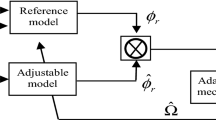Abstract
This paper proposes a novel sensorless and sensor-based speed control of a doubly fed induction machine (DFIM). The proposed methodology consists of using the principle of rotor flux-oriented control (RFOC) to eliminate the cross-coupling that occurs between the rotor flux and the electromagnetic torque of the DFIM system. For the sensor-based mechanical speed control case, a robust fuzzy logic controller (FLC) is synthesized. For the sensorless speed control case, the Luenberger observer is proposed to optimally estimate the unknown mechanical speed, which is then employed in the FLC synthesis. The control methodology including the RFOC principle and the FLC synthesis equipped with the Luenberger observer is therefore the main contribution of this paper. Typically, the closed-loop system is simulated by a single pulse-width modulated (PWM) inverter, which is linked to the DFIM system's rotor, where the corresponding rotational speed is often controlled using a conventional proportional–integral (PI) controller. The controller parameters are accordingly tuned from the datasheet describing the machine using guideline-based tuning rules, available in conventional synthesis methods. Unfortunately, such tuning requires rigorous computational time and extensive prior knowledge of DFIM parameter set. To overcome this drawback, the speed control based on the existing conventional PI controller is replaced by the one based on the proposed robust FLC for speed control with sensor and the proposed FLC equipped with Luenberger observer for the sensorless speed control. The simulation results show the superiority of the proposed control strategy over the one provided by the conventional PI controller-based RFOC strategy, in terms of reference tracking dynamic and closed-loop robustness against inappropriate DFIM model parameters.

















Similar content being viewed by others
Data availability
All data and code is available with an open source from https://github.com/yousfi26/Matlab-Simulink-codes.
References
Naveen G, Sarvesh PKS, Krishna BR (2013) DTC control strategy for doubly fed induction machine. Int J Eng Adv Technol 3(1):92–95
Abad G, Lopez J, Rodriguez M, Marroyo L, Iwanski G (2011) Doubly fed induction machine: modeling and control for wind energy generation, vol 85. Wiley
Poller MA (2003) Doubly-fed induction machine models for stability assessment of wind farms. In: 2003 IEEE Bologna power tech conference proceedings, vol 3. IEEE, p. 6
Feijóo A, Cidrás J, Carrillo C (2000) A third order model for the doubly-fed induction machine. Electric Power Syst Res 56(2):121
Chikouche TM, Mezouar A, Terras T, Hadjeri S (2015) Sensorless nonlinear control of a doubly fed induction motor using Luenberger observer. In: 2015 4th international conference on electrical engineering (ICEE). IEEE, pp 1–7
Tapia A, Tapia G, Ostolaza JX, Saenz JR (2003) Modeling and control of a wind turbine driven doubly fed induction generator. IEEE Trans Energy Convers 18(2):194–204
Shipurkar U, Strous TD, Polinder H, Ferreira JA, Veltman A (2017) Achieving sensorless control for the brushless doubly fed induction machine. IEEE Trans Energy Convers 32(4):1611–1619
Vicatos MS (2003) A doubly fed induction machine differential drive model for automobiles. IEEE Trans Energy Convers 18(2):225–230
Zarei ME, Platero CA, Nicolás CV, Arribas JR (2019) Novel differential protection technique for doubly fed induction machines. IEEE Trans Ind Appl 55(4):3697–3706
Hopfensperger B, Atkinson DJ, Lakin RA (2000) Stator-flux-oriented control of a doubly-fed induction machine: with and without position encoder. IEE Proc Electric Power Appl 147(4):241–250
Jovanovic M (2009) Sensored and sensorless speed control methods for brushless doubly fed reluctance motors. IET Electr Power Appl 3(6):503–513
Lacchetti MF (2011) Adaptive tuning of the stator inductance in a rotor-current-based MRAS observer for sensorless doubly fed induction-machine drives. IEEE Trans Ind Electron 58(10):4683–4692
Xu L, Inoa E, Liu Y, Guan B (2012) A new high-frequency injection method for sensorless control of doubly fed induction machines. IEEE Trans Ind Appl 48(5):1556–1564
Bhuvaneshvari K, Mahendran MG (2014) PI and fuzzy based sensor less speed control of induction motor. OSR Electr Electron Eng (IOSR-JEEE) 9(2):41–46
Rani MA, Nagamani C, Ilango GS (2016) An improved rotor PLL (R-PLL) for enhanced operation of doubly fed induction machine. IEEE Trans Sustain Energy 8(1):117–125
Cherifi D, Miloud Y (2018) Robust speed-sensorless vector control of doubly fed induction motor drive using sliding mode rotor flux observer. Int J Appl 7(3):235–250
Bahloul M, Chrifi-Alaoui L, Drid S, Souissi M, Chaabane M (2018) Robust sensorless vector control of an induction machine using multiobjective adaptive fuzzy Luenberger observer. ISA Trans 74:144–154
Luo YC, Huang WA (2019) Sensorless rotor field direct orientation-controlled induction motor drive with particle swarm optimization algorithm flux observer. J Low Freq Noise Vib Act Control 38(2):692–705
Avlasko PV, Bronov SA (2019) Electric drives on the basis of doubly fed induction motor. IOP Conf Ser Mater Sci Eng 643(1):012035
Gonti G, Ebrahim A, Murphy G (2019) Modeling and control of a grid connected wind turbine power system under variable wind speeds using doubly-fed induction machine. J Power Electron Power Syst 5(3):108–124
Bodson M (2019) Speed control for doubly fed induction motors with and without current feedback. IEEE Trans Control Syst Technol 28:898–907
Acknowledgements
The authors would like to thank Dr. Boulsina Fayçal for his significant comments that enhanced the current paper.
Funding
This research received no specific grant from any funding agency in the public, commercial, or not-for-profit sectors.
Author information
Authors and Affiliations
Contributions
Yousfi Laatra, Aoun Sakina, and Sedraoui Moussa contributed equally to the preparation of this manuscript.
Corresponding author
Ethics declarations
Conflict of interest
The authors reported no potential conflict of interest.
Rights and permissions
About this article
Cite this article
Yousfi, L., Aoun, S. & Sedraoui, M. Speed sensorless vector control of doubly fed induction machine using fuzzy logic control equipped with Luenberger observer. Int. J. Dynam. Control 10, 1876–1888 (2022). https://doi.org/10.1007/s40435-022-00946-0
Received:
Revised:
Accepted:
Published:
Issue Date:
DOI: https://doi.org/10.1007/s40435-022-00946-0






